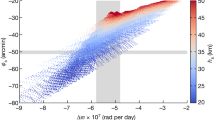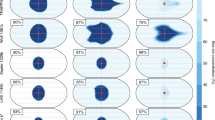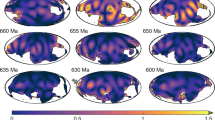Abstract
The Cassini mission has provided measurements of the gravity of several moons of Saturn as well as an estimate of the tidal response, which is expressed as the degree 2 Love number k2 of its largest moon, Titan. The first estimates of Titan’s Love number were larger than pre-Cassini expectations. Interior modelling suggested it may be explained with a dense ocean, but the interpretation remains unclear. We analysed Cassini tracking data to determine Titan’s gravity field and its Love number. Our gravity results are consistent with earlier studies, but we find a lower Love number for Titan of k2 = 0.375 ± 0.06. This lower value follows from an elaborate investigation of the tidal effects. We show that a dense ocean is not implied by the obtained Love number; instead, a water or ammonia ocean is more probable. A lower density ocean can increase the likeliness of contact between the silicate core and ocean, which can leach minerals into the ocean and could promote its habitability.
This is a preview of subscription content, access via your institution
Access options
Access Nature and 54 other Nature Portfolio journals
Get Nature+, our best-value online-access subscription
$29.99 / 30 days
cancel any time
Subscribe to this journal
Receive 12 digital issues and online access to articles
$119.00 per year
only $9.92 per issue
Buy this article
- Purchase on Springer Link
- Instant access to full article PDF
Prices may be subject to local taxes which are calculated during checkout




Similar content being viewed by others
Data availability
Cassini radio tracking data and ancillary information can be found at the Planetary Data System’s Atmospheres node (https://pds-atmospheres.nmsu.edu/data_and_services/atmospheres_data/Cassini/inst-rss.html). Results from our analysis such as the gravity field models and output from our MCMC modelling are available via NASA’s Planetary Geodesy Data Archive at https://pgda.gsfc.nasa.gov/products/91 or https://doi.org/10.60903/gsfcpgda-titank2.
Code availability
We used the open source software TidalPy to analyse Titan’s Love number (https://doi.org/10.5281/zenodo.7017474 (ref. 43)) and the emcee open source software32 for our MCMC analysis (https://emcee.readthedocs.io/en/stable/). We also used the PlanetProfile software44 (https://github.com/vancesteven/PlanetProfile) to compute the self-consistent interior models for Titan used in our modelling. The input data for the MCMC analysis are the results presented in this work; additional input parameters for TidalPy are discussed in the text and listed in Supplementary Table 4. We also used the Python package corner45 for the distribution plot in Supplementary Information. We cannot provide the software used for the analysis of the Cassini tracking data, but the methods have long been established and are described in detail in Methods. All figures (apart from the distribution plot in Supplementary Fig. 5) were drawn with the free software GMT (https://www.generic-mapping-tools.org/)46.
Change history
14 May 2024
A Correction to this paper has been published: https://doi.org/10.1038/s41550-024-02289-6
References
Iess, L. et al. Gravity field, shape, and moment of inertia of Titan. Science 327, 1367–1369 (2010).
Tortora, P. et al. Rhea gravity field and interior modeling from Cassini data analysis. Icarus 264, 264–273 (2016).
Durante, D., Hemingway, D. J., Racioppa, P., Iess, L. & Stevenson, D. J. Titan’s gravity field and interior structure after Cassini. Icarus 326, 123–132 (2019).
Zannoni, M., Hemingway, D., Gomez Casajus, L. & Tortora, P. The gravity field and interior structure of Dione. Icarus 345, 113713 (2020).
Iess, L. et al. Measurement and implications of Saturn’s gravity field and ring mass. Science 364, aat2965 (2019).
Iess, L. et al. The tides of Titan. Science 337, 457–459 (2012).
Lunine, J. I. & Stevenson, D. J. Clathrate and ammonia hydrates at high pressure: application to the origin of methane on Titan. Icarus 70, 61–77 (1987).
Grasset, O. & Sotin, C. The cooling rate of a liquid shell in Titan’s interior. Icarus 123, 101–112 (1996).
Grasset, O., Sotin, C. & Deschamps, F. On the internal structure and dynamics of Titan. Planet. Space Sci. 48, 617–636 (2000).
Sohl, F., Hussmann, H., Schwentker, B., Spohn, T. & Lorenz, R. D. Interior structure models and tidal Love numbers of Titan. J. Geophys. Res. Planets 108, 5130 (2003).
Rappaport, N., Bertotti, B., Giampieri, G. & Anderson, J. D. Doppler measurements of the quadrupole moments of Titan. Icarus 126, 313–323 (1997).
Rappaport, N. J. et al. Can Cassini detect a subsurface ocean in Titan from gravity measurements? Icarus 194, 711–720 (2008).
Sohl, F. et al. Structural and tidal models of Titan and inferences on cryovolcanism. J. Geophys. Res. Planets 119, 1013–1036 (2014).
Sotin, C., Kalousová, K. & Tobie, G. Titan’s interior structure and dynamics after the Cassini–Huygens mission. Annu. Rev. Earth Planet. Sci. 49, 579–607 (2021).
Stiles, B. W. et al. Determining Titan’s spin state from Cassini RADAR images. Astron. J. 135, 1669–1680 (2008).
Zebker, H. A. et al. Size and shape of Saturn’s moon Titan. Science 324, 921–923 (2009).
Mitri, G. et al. Shape, topography, gravity anomalies and tidal deformation of Titan. Icarus 236, 169–177 (2014).
Baland, R.-M., Tobie, G., Lefèvre, A. & Van Hoolst, T. Titan’s internal structure inferred from its gravity field, shape, and rotation state. Icarus 237, 29–41 (2014).
Beuthe, M. Tidal Love numbers of membrane worlds: Europa, Titan, and co. Icarus 258, 239–266 (2015).
Iess, L. et al. The gravity field and interior structure of Enceladus. Science 344, 78–80 (2014).
Murray, C. & Dermott, S. Solar System Dynamics (Cambridge Univ. Press, 1999).
Meriggiola, R., Iess, L., Stiles, B. W., Lunine, J. I. & Mitri, G. The rotational dynamics of Titan from Cassini RADAR images. Icarus 275, 183–192 (2016).
Fortes, A. D. Titan’s internal structure and the evolutionary consequences. Planet. Space Sci. 60, 10–17 (2012).
Gao, P. & Stevenson, D. J. Nonhydrostatic effects and the determination of icy satellites’ moment of inertia. Icarus 226, 1185–1191 (2013).
Coyette, A., Baland, R.-M. & Van Hoolst, T. Variations in rotation rate and polar motion of a non-hydrostatic Titan. Icarus 307, 83–105 (2018).
Zharkov, V. N., Leontjev, V. V. & Kozenko, V. A. Models, figures, and gravitational moments of the Galilean satellites of Jupiter and icy satellites of Saturn. Icarus 61, 92–100 (1985).
Asmar, S. W., Armstrong, J. W., Iess, L. & Tortora, P. Spacecraft Doppler tracking: noise budget and accuracy achievable in precision radio science observations. Radio Sci. 40, RS2001 (2005).
Ermakov, A. I., Park, R. S. & Bills, B. G. Power laws of topography and gravity spectra of the Solar System bodies. J. Geophys. Res. Planets 123, 2038–2064 (2018).
Eanes, R., Schutz, B. & Tapley, B. Earth and ocean tide effects on Lageos and Starlette. In Proc. 9th International Symposium on Earth Tides (ed. Kuo, J. T.) 239–249 (E. Schweizerbart, 1983).
McCarthy, D. D. & Petit, G. IERS Conventions (2003) Technical Note 32 (IERS, 2004).
Vance, S. D. et al. Geophysical investigations of habitability in ice-covered ocean worlds. J. Geophys. Res. Planets 123, 180–205 (2018).
Foreman-Mackey, D., Hogg, D. W., Lang, D. & Goodman, J. emcee: The MCMC hammer. Publ. Astron. Soc. Pac. 125, 306 (2013).
Pavlis, D. E. & Nicholas, J. B. GEODYN II system description (vols. 1–5). Contractor report, (SGT Inc., 2017); https://earth.gsfc.nasa.gov/geo/data/geodyn-documentation
Bertotti, B., Iess, L. & Tortora, P. A test of general relativity using radio links with the Cassini spacecraft. Nature 425, 374–376 (2003).
Archinal, B. A. et al. Report of the IAU Working Group on Cartographic Coordinates and Rotational Elements: 2015. Celest. Mech. Dyn. Astron. 130, 22 (2018).
Bellerose, J., Roth, D. & Criddle, K. in Space Operations: Inspiring Humankind’s Future (eds Pasquier, H. et al.) 575–588 (Springer, 2019); https://arc.aiaa.org/doi/10.2514/6.2018-2646
Barbaglio, F., Armstrong, J. W. & Iess, L. Precise Doppler measurements for navigation and planetary geodesy using low gain antennas: test results from Cassini. In Proc. 23rd International Symposium on Space Flight Dynamics (German Aerospace Center, 2012); https://issfd.org/ISSFD_2012/ISSFD23_OD1_4.pdf
Montenbruck, O. & Gill, E. Satellite Orbits (Springer-Verlag, 2000).
Tapley, B. D., Schutz, B. E. & Born, G. H. Statistical Orbit Determination (Elsevier, 2004).
Kusche, J. Noise variance estimation and optimal weight determination for GOCE gravity recovery. Adv. Geosci. 1, 81–85 (2003).
Běhounková, M., Souček, O., Hron, J. & Čadek, O. Plume activity and tidal deformation on Enceladus influenced by faults and variable ice shell thickness. Astrobiology 17, 941–954 (2017).
Hemingway, D. J. & Mittal, T. Enceladus’s ice shell structure as a window on internal heat production. Icarus 332, 111–131 (2019).
Renaud, J. P. TidalPy (0.4.1). Zenodo https://doi.org/10.5281/zenodo.7017474 (2023).
Styczinski, M. J., Vance, S. D. & Melwani Daswani, M. Planetprofile: self-consistent interior structure modeling for ocean worlds and rocky dwarf planets in Python. Earth Space Sci. 10, e2022EA002748 (2023).
Foreman-Mackey, D. corner.py: scatterplot matrices in Python. J. Open Source Softw. 1, 24 (2016).
Wessel, P., Smith, W. H. F., Scharroo, R., Luis, J. & Wobbe, F. Generic Mapping Tools: improved version released. Eos Trans. Am. Geophys. Union 94, 409–410 (2013).
Kaula, W. M. Theory of Satellite Geodesy, Applications of Satellites to Geodesy (Blaisdell Publishing Company, 1966).
Acknowledgements
This work was funded by NASA’s Cassini Data Analysis Program (S.G., B.v.N. and E.M.). We thank T. Sabaka (NASA/GSFC), S. Bertone (NASA/GSFC, University of Maryland, Baltimore County, and CRESST II), W. Henning and J. Renaud (NASA/GSFC, University of Maryland and CRESST II), G. Cascioli (NASA/GSFC and University of Maryland, Baltimore County), and D. Durante and L. Iess (Sapienza University of Rome, Italy) for discussions.
Author information
Authors and Affiliations
Contributions
S.G. and E.M. conceived and designed the study. S.G., B.v.N. and A.M. analysed the Cassini tracking data. E.M. supported the analysis of the Cassini tracking data. W.v.d.W. provided theoretical support. All authors contributed to the discussion and interpretation of the results. S.G. wrote the first draft of the paper. All authors contributed to subsequent drafts.
Corresponding author
Ethics declarations
Competing interests
The authors declare no competing interests.
Peer review
Peer review information
Nature Astronomy thanks Sebastien Le Maistre, Marzia Parisi and the other, anonymous, reviewer(s) for their contribution to the peer review of this work.
Additional information
Publisher’s note Springer Nature remains neutral with regard to jurisdictional claims in published maps and institutional affiliations.
Supplementary information
Supplementary Information
Supplementary Figs. 1–13, Tables 1–4 and references.
Rights and permissions
About this article
Cite this article
Goossens, S., van Noort, B., Mateo, A. et al. A low-density ocean inside Titan inferred from Cassini data. Nat Astron (2024). https://doi.org/10.1038/s41550-024-02253-4
Received:
Accepted:
Published:
DOI: https://doi.org/10.1038/s41550-024-02253-4



